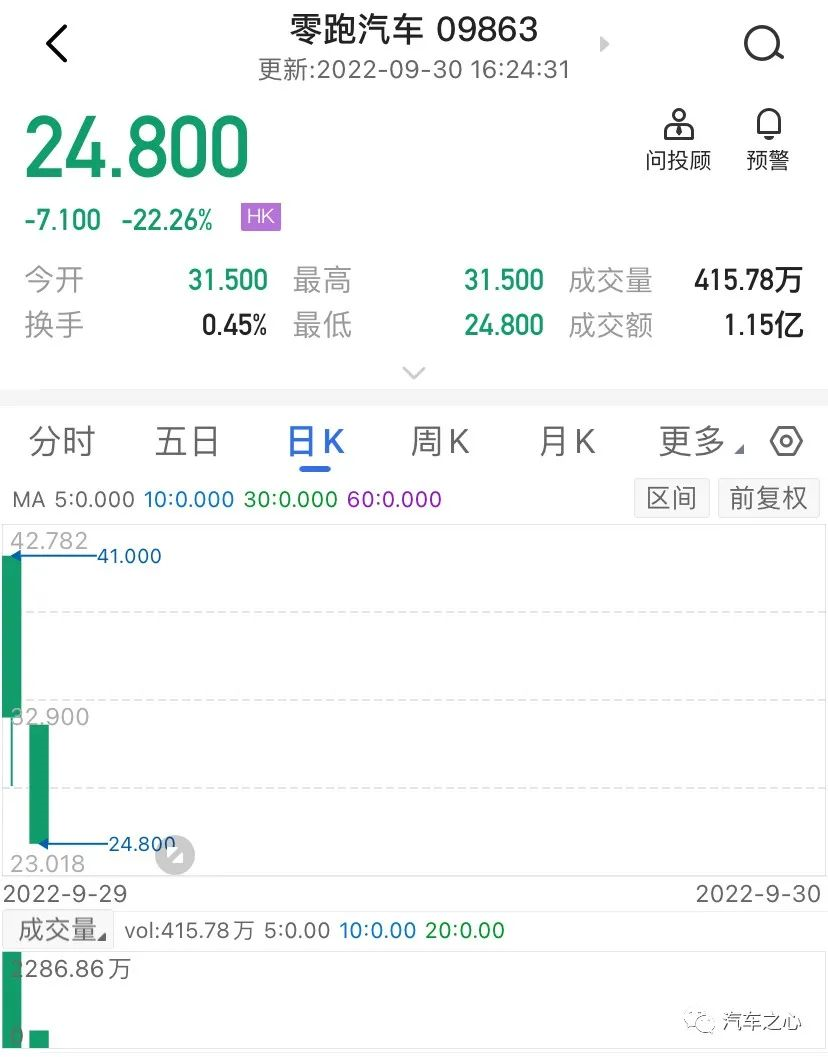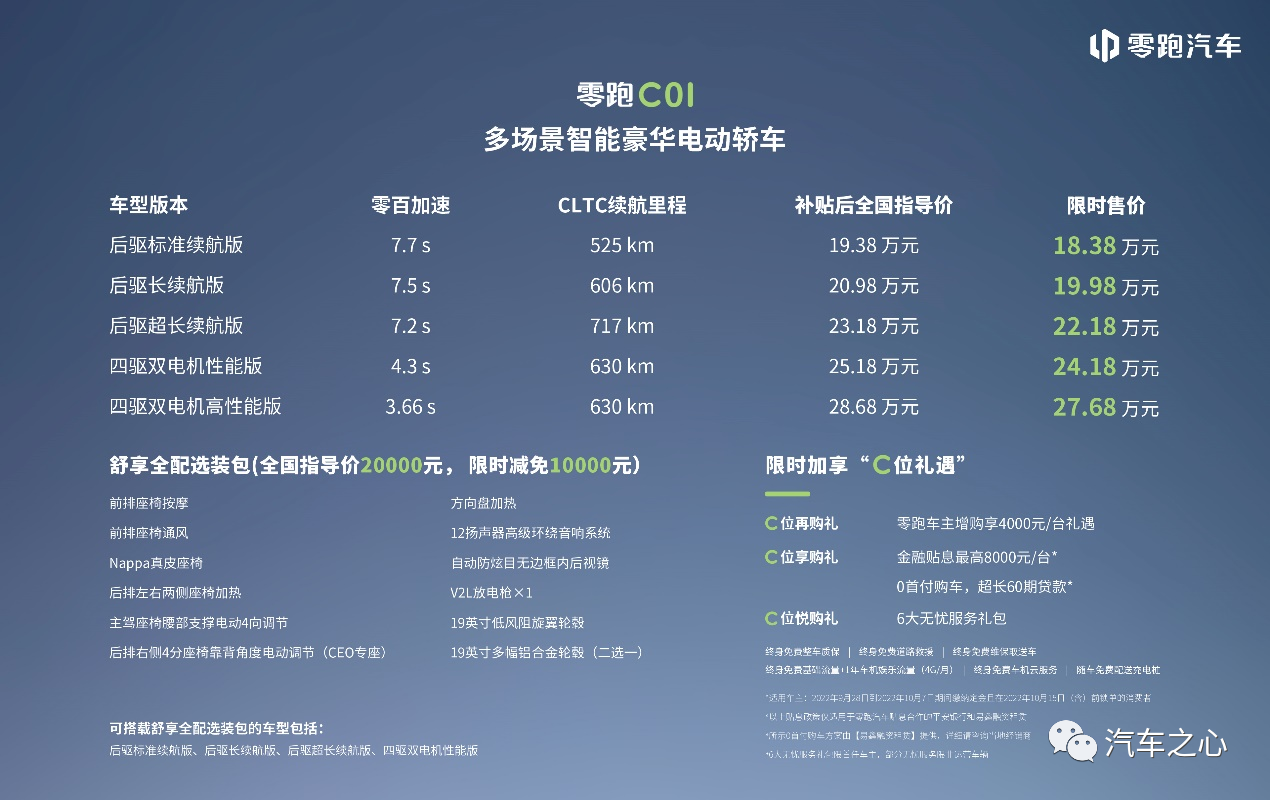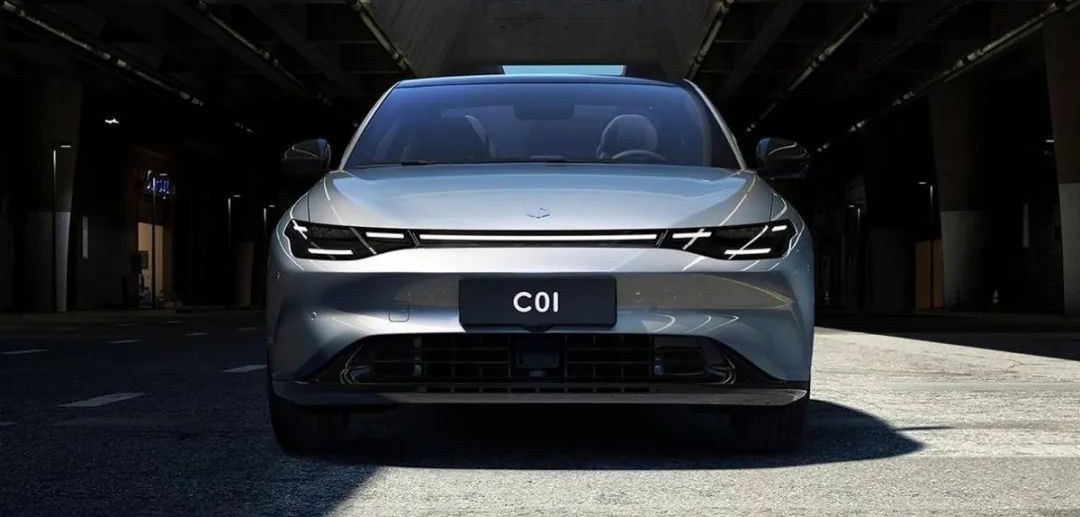Author: Xu Jinkai
This is a big day for Leapmotor, and also a difficult time for Zhu Jiangming.
On September 29, Leapmotor (09863.HK) was listed on the Hong Kong Stock Exchange at an issue price of HKD 48 per share. However, the stock price fell to HKD 31.90 per share at the close of the first day of trading, a decrease of 33.542%.
The next day, the closing price continued to fall to HKD 24.8 per share, which was nearly halved compared to the issue price of HKD 48.

On the eve of the Hong Kong stock market listing, Leapmotor officially launched its flagship model, the Leapmotor C01. This intensive arrangement implies that Leapmotor hopes to attract strong market attention with the generous configuration and price of the C01, and thus make a splash in the capital market.
However, the market reaction was not strong, and the capital market does not seem to be receptive.
No one knows the generosity of Leapmotor
Although it is unfair to attribute the stock price trend solely to the market response to the Leapmotor C01, it did not have a significant impact as the opening act of the Hong Kong stock market listing.
As a model rated as conscientious in the industry, the Leapmotor C01 has a fairly affordable price.
According to the classification standards of traditional fuel cars, with a body length exceeding 5 meters comparable to the Audi A6, the Leapmotor C01 is a standard C-class car, but its price is entangled with other B-class cars such as Accord.
The official price of the Leapmotor C01 ranges from CNY 193,800 to CNY 286,800. The five versions of the car only differ in battery capacity and single/dual motor, while the other 80 intelligent luxury configurations are all standard.
Obviously, larger body size and more comprehensive configurations are Leapmotor C01’s weapons to compete with traditional fuel cars for market share.

The length, width, and height of the Leapmotor C01 are 5050×1902×1509mm respectively, and the wheelbase is as long as 2930mm. It not only has a significant competitive advantage over traditional models in the same price range, such as Accord and Passat, but also has a larger size and better space performance than new energy models such as XPeng P7 and BYD Han.
It is not an exaggeration to say that the Leapmotor C01 is the model with the best space performance in the same price range.
In addition to its spacious interior, the power performance of the Leapmotor C01 is also outstanding. Among them, the single-motor ultra-long-range version of the car has a comprehensive working condition range of 717km, while the acceleration of the dual-motor performance version is only 3.66 seconds per hundred kilometers.The most notable thing is that, apart from the differences in the number of motors and the range, all other configurations of the Leapmotor C01 are the same. Consumers only need to choose the appropriate model according to their needs, greatly reducing the difficulty of choice.
In addition, the Leapmotor C01 is also equipped with the Qualcomm SA 8155P digital cockpit chip. Thanks to the super strong computing power of this chip, the Leapmotor C01 has become the first car model in the industry to achieve seamless linkage of three screens: a 10.25-inch LCD meter, a 12.8-inch intelligent car entertainment system, and a 10.25-inch entertainment screen.
In addition, the new car is equipped with the Leapmotor Pilot intelligent driving assistance system, which can realize multiple L2++ level intelligent driving assistance functions, such as HWA high-speed auxiliary driving, ICA high-speed cruise assistance, and TJA traffic jam assistance.
Whether from the perspective of space performance, intelligence level, or technology configuration, the Leapmotor C01 can be regarded as a breath of fresh air in the automobile market. However, such generous configuration has not caused much market response.
C01 Blocks the Battle for Traditional Mid-to-High-End Cars
“The car is large enough, the materials are solid enough, and the luxury feeling is also good, but I don’t have much confidence in its intelligent driving assistance,” said a potential consumer of the Leapmotor C01. The concerns of consumers like this, to some extent, indicate that the market’s brand recognition of Leapmotor is not clear.
Compared with many obvious tags such as NIO battery swap and service, Ideal father car, XiaoPeng NGP, and technology, Leapmotor is more labeled with generous and cost-effective tags. However, in the eyes of many consumers, cost-effectiveness largely means insufficient technical strength, which leads to a lack of confidence in the Leapmotor C01 driving assistance system.
In addition to the insufficient technical image, the market pattern faced by the Leapmotor C01 is also difficult to overturn.
In the era of fuel vehicles, there was a saying that “whoever dominates the mid-to-high-end car market dominates the world”. This largely indicates the importance of this market. In order to successfully take this market, all brands have applied the most advanced technology to the corresponding models, resulting in the situation where Japanese brands such as Accord and Camry and German brands such as Passat and Magotan take turns in the forefront.
After decades of development, the image of Accord, Camry, Passat, and other brands has already taken root in people’s hearts. The difficulty faced by the novice Leapmotor C01 can be imagined.For LI Auto, this is a battle that cannot be lost.
From the “micro-car” aborted in the womb to the AE86 for young Chinese people represented by the S01, to the sales support from the T03 and the challenge to the mid-to-high end SUV market represented by C11, LI Auto led by Zhu Jiangming has gone through many adjustments until the launch of the C01, and the pattern of C11+C01 working together towards the top was thus formed, with “making luxury cars for the Chinese people” becoming Zhu Jiangming’s proud goal.
According to data from the China Passenger Car Association, LI Auto sold a total of 76,563 vehicles in the first eight months of this year, including 31,774 units of the C11, which is poised to rival the sales pillar of the T03, and with the addition of the C01, the higher-priced combination C11+C01 will gradually become LI Auto’s main sales force, further enhancing the market recognition and brand image of LI Auto.
Full-stack independent research and development is a difficult starting point.
If the recently launched C01 was the main factor causing short-term fluctuations in LI Auto’s stock price, then the development strategy of full-stack independent research and development will determine the future trend of LI Auto’s stock price.
“LI Auto has always adhered to a user-centered value proposition, committed to becoming a respected world-class electric vehicle enterprise. Since its founding, we have always regarded forward-looking technology as the best answer to give back to our users, and through full-domain independent research and development and manufacturing, we have mastered the core technology of intelligent electric vehicles and provided different consumers with a higher-level experience.” Zhu Jiangming said at the launch of the C01.
Higher independent research and development levels mean higher investment. According to LI Auto’s prospectus:
In 2019, 2020, and 2021, the net loss was RMB 901 million yuan, RMB 1.1 billion yuan, and RMB 2.846 billion yuan, respectively. LI Auto’s total net loss over the past three years was RMB 4.85 billion yuan. In the first quarter of 2022, the net loss was RMB 1.072 billion yuan, compared to a net loss of RMB 398 million yuan for the same period last year, an increase of 2.7 times.
In 2019, 2020, 2021, and the first quarter of 2022, revenue was RMB 117 million yuan, RMB 631 million yuan, RMB 3.113 billion yuan, and RMB 1.991 billion yuan, respectively.
In 2019, 2020, 2021, and the first quarter of 2022, the gross profit margin was -95.7%, -50.6%, -44.3%, and -26.6%, respectively.The research and development (R&D) expenditures for the years 2019, 2020, and 2021 were CNY 358 million, CNY 289 million, and CNY 740 million, respectively, accounting for 306.4%, 45.8%, and 23.6% of the revenue.
When looking back at the technological development of LeapMotor, the non-CTC battery chassis integration technology draws attention. This technology integrates the battery with the chassis structure, utilizing the vehicle body as the external structure of the battery pack while maximizing the use of space. At the same time, the vehicle body torsional stiffness is improved by 25%.
This change in layout structure is similar to BYD’s blade battery, but LeapMotor’s non-CTC battery chassis integration approach is more radical.
However, the treatment of LeapMotor and BYD in the capital market is quite different. This is mainly because BYD possesses the most essential three-electric technology and has the ability to produce and sell batteries themselves. LeapMotor and other automakers do not possess such strengths.
In addition, data shows that in smart electric vehicles, the cost of the three-electric system accounts for the largest proportion, approximately 51.3% of the vehicle’s materials cost, while the hardware cost of the intelligent network system (including intelligent cockpit + autonomous driving) accounts for approximately 16%.
According to LeapMotor, funds raised after going public will be used to expand the range of smart electric vehicle products, expand the team, and research and develop intelligent technologies, such as autonomous driving, to improve production capacity and brand awareness.
While backed by the security giant Dahua, LeapMotor has excellent hardware support in the field of autonomous driving. However, such an advantage cannot be compared to the three-electric system, which accounts for more than half of the cost. This is the main reason why vehicle manufacturers like LeapMotor are not valued in the capital market.
Regarding the company’s stock price’s first-day plunge, LeapMotor Chairman Zhu Jiangming stated, “It is indeed not a very good time period because the global situation is volatile and in a downturn. But we choose to go public mainly because we don’t care about the current time period. This is a long-distance race. What we care about more is how the real quality is and how we can quickly obtain our market share.”
Indeed, it was not an ideal time. According to incomplete statistics, on the night of LeapMotor C01’s listing, the industry also saw the launch of cars such as CR-V, Haval H6 PHEV, Changan Ruicheng PLUS, and BYD even released its Han Tang Yuan three models in the European market.During the same period, many new car models went on the market, which to a certain extent diverted the influence of LVCHI Auto C01 and consequently affected LVCHI Auto’s impact on the capital market.
What’s more, the frenzy of competition in the intelligent electric vehicle field has brought the industry into a new phase of development.
Recently, XPeng G9, which had been listed for less than 48 hours, adjusted its model configuration and price, which was followed by the Abiona offering a 40,000 yuan worth of equity and the previous move of Zeekrai offering free replacement of the 8155 chip. This has caused many insiders to lower their expectations for the development of intelligent electric vehicles.
As a new development in the automotive market, intelligent electric vehicles target users who are more willing to accept new things and attach greater importance to the new experience that the new car brings. However, these early adopters are only a small minority. As time goes by, more conservative consumers who value actual driving experiences, such as range, space, driving quality, and maintenance convenience, will gradually become the main consumers in the market.
Unlike early adopters who pursue novelty, conservative consumers are more concerned about practical experiences such as range, space, driving quality, and maintenance convenience. LVCHI Auto has largely taken over this group of consumers, and this is also a significant reason for LVCHI Auto’s strong sales performance.
According to LVCHI Auto’s latest sales data, in the just-ended September, LVCHI Auto sold 11,039 cars per month, second only to NIO and LI Auto.
“The monthly sales of ten thousand vehicles may just mark the end of the elimination round, which is equivalent to getting a ticket to the qualifying round. The preliminary competition of new energy vehicles should continue until the day when new energy vehicles completely replace fuel vehicles. Only when all vehicles are new energy vehicles, will we enter the final, just as smartphones replaced traditional cellphones.” Zhu Jiangming once said in public.
Indeed, although the growth rate of the new energy vehicle market is very fast, its overall sales volume still cannot be compared with the traditional fuel vehicles. On the road to replacing fuel vehicles, more serious competition will continue, and LVCHI Auto, with capital support, will have greater autonomy than those new brands that have yet to be launched.
However, the reality of the LVCHI Auto IPO also sounds an alarm for LVCHI, and LVCHI Auto’s road to leadership is still long.
This article is a translation by ChatGPT of a Chinese report from 42HOW. If you have any questions about it, please email bd@42how.com.
